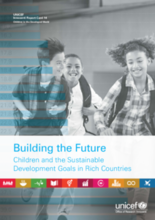Introduction:
The Sustainable Development Goals have set ambitious targets that apply to rich countries as well as poor. The most telling sign of a nation’s progress towards meeting those goals will be how well it meets the needs of its children.
This Report Card offers an assessment of child well-being in the context of sustainable development across 41 countries of the European Union (EU) and the Organisation for Economic Co-operation and Development (OECD). This group includes both high- and middle-income economies, but here we refer to them all as ‘high-income countries’ – or ‘rich countries’, for convenience. The concept of child well-being is rooted in the Convention on the Rights of the Child (CRC) but the Agenda for Sustainable Development adds new dimensions. Progress across all these dimensions will be vital to children, and advanced economies will therefore need to monitor the situation of children and young people both nationally and globally.
Focus on Care:
"How national averages hide the vulnerable: the example of indigenous children" (Box 6) featured on page 51 of the report, states that despite the central promise of the Sustainable Development Goals to "leave no one behind," national averages often fail to report the most disadvantaged and excluded children. The report names "indigenous children, Roma, undocumented migrants, children with disabilities or those outside family care" as groups falling outside national averages and provides a focus on indigenous children from Australia, Canada, Mexico and Norway.

